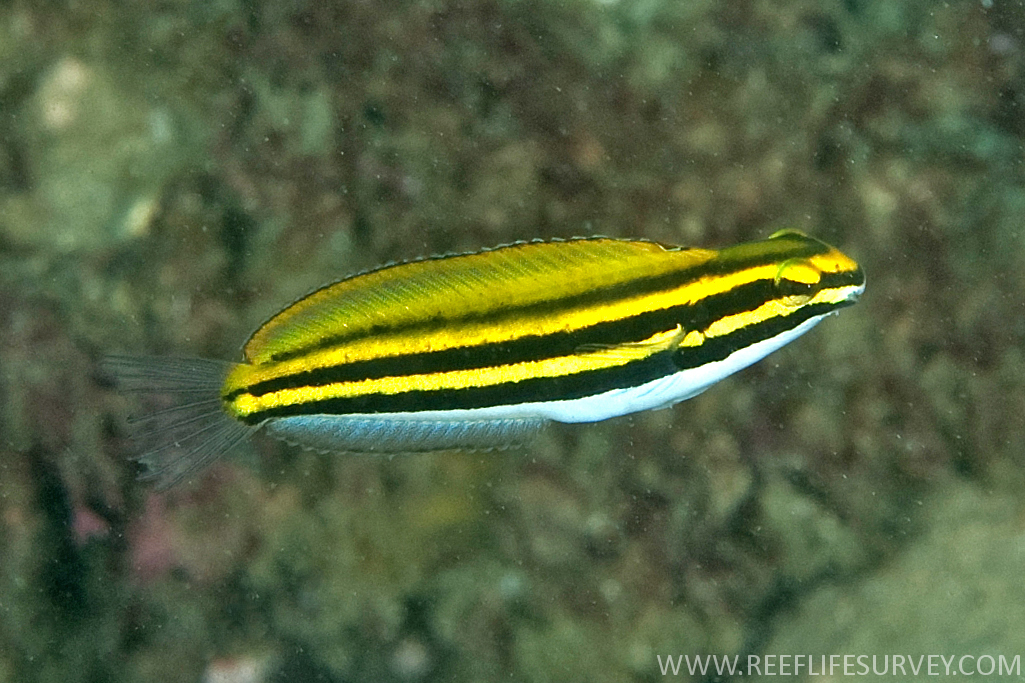Lined Fangblenny, Meiacanthus lineatus (De Vis 1884)
Other Names: Yellow-lined Harp-tail, Yellow-lined Harptail Blenny

A Lined Fangblenny, Meiacanthus lineatus, at Cook Island, south of Tweed Heads, New South Wales, June 2011. Source: Ian Shaw / Reef Life Survey. License: CC By Attribution
Summary:
A combtooth blenny with two dark lateral stripes, one immediately above the pectoral fin and one from the chin running below the eye through the pectoral-fin base, usually separated by a yellow stripe (sometimes a white stripe). The species is a white below and has a narrow dark stripe along the dorsal-fin base, a black submarginal band on the dorsal fin, and a yellow caudal fin.
The dark stripe running through the eye is separated from the margin of the upper lip by a broad pale area that is about equal to, or wider than the width of the dark stripe.
The dark stripe running through the eye is separated from the margin of the upper lip by a broad pale area that is about equal to, or wider than the width of the dark stripe.
Cite this page as:
Bray, D.J. 2021, Meiacanthus lineatus in Fishes of Australia, accessed 27 Jun 2025, https://fishesofaustralia.net.au/Home/species/4739
Lined Fangblenny, Meiacanthus lineatus (De Vis 1884)
More Info
|
Distribution |
Endemic to eastern Australia, from the Torres Strait, Queensland, to at least Sydney, New South Wales. |
|
Remarks |
The Lined Fangblenny has a pair of venomous canines in the lower jaw that they use for protection against predators and to protect their territory - not for feeding. This species is mimicked by the Yellow Sabretooth Blenny, Petroscirtes fallax, and juvenile Two-line Monocle Bream, Scolopsis bilineata. |
|
Etymology |
The specific name is from the Latin lineatus (= lined), in reference to the three dark stripes on head and body, separated by pale interspaces, all of approximately equal width |
|
Species Citation |
Petroscirtes lineatus De Vis, 1884, Proc. Linn. Soc. N. S. W. 9(3): 698. Type locality: Murray Island, Torres Strait, Queensland. |
|
Author |
Bray, D.J. 2021 |
|
Resources |
Lined Fangblenny, Meiacanthus lineatus (De Vis 1884)
References
De Vis, C.W. 1884. New fishes in the Queensland Museum. No. 4. Proceedings of the Linnean Society of New South Wales 1 9(3): 685-698 See ref at BHL
Johnson, J.W. 2010. Fishes of the Moreton Bay Marine Park and adjacent continental shelf waters, Queensland, Australia. pp. 299-353 in Davie, P.J.F. & Phillips, J.A. Proceedings of the Thirteenth International Marine Biological Workshop, The Marine Fauna and Flora of Moreton Bay. Memoirs of the Queensland Museum 54(3)
Kuiter, R.H. 1992. Tropical Reef-Fishes of the Western Pacific, Indonesia and Adjacent Waters. Jakarta : PT Gramedia Pustaka Utama 314 pp. pls.
Kuiter, R.H. 1993. Coastal Fishes of South-eastern Australia. Bathurst : Crawford House Press 437 pp.
Kuiter, R.H. 1996. Guide to Sea Fishes of Australia. A comprehensive reference for divers and fishermen. Sydney, NSW, Australia : New Holland Publishers xvii, 434 pp.
Randall, J.E., Allen, G.R. & Steene, R. 1990. Fishes of the Great Barrier Reef and Coral Sea. Bathurst : Crawford House Press 507 pp. figs.
Randall, J.E., Allen, G.R. & Steene, R. 1997. Fishes of the Great Barrier Reef and Coral Sea. Bathurst : Crawford House Press 557 pp. figs.
Smith-Vaniz, W.F. 1976. The saber-toothed blennies, tribe Nemophini (Pisces : Blenniidae). Monographs of the Academy of Natural Sciences of Philadelphia 19: 1-196 figs 1-179
Smith-Vaniz, W.F. 1987. The saber-toothed blennies, tribe Nemophini (Pisces: Blenniidae): an update. Proceedings of the Academy of Natural Sciences, Philadelphia 139: 1-52 figs 1-29
Smith-Vaniz, W.F. & Allen, G.R. 2011. Three new species of the fangblenny genus Meiacanthus from Indonesia, with color photographs and comments on other species (Teleostei: Blenniidae: Nemophini). Zootaxa 3046: 39-58
Smith-Vaniz, W. F., Satapoomin, U. & Allen, G.R. 2001. Meiacanthus urostigma, a new fangblenny from the northeastern Indian Ocean, with discussion and examples of mimicry in species of Meiacanthus (Teleostei: Blenniidae: Nemophini). aqua, Journal of Ichthyology and Aquatic Biology 5(1): 25-43 See ref online
Williams, J.T. 2014. Meiacanthus lineatus. The IUCN Red List of Threatened Species 2014: e.T48342417A48379268. https://dx.doi.org/10.2305/IUCN.UK.2014-3.RLTS.T48342417A48379268.en. Downloaded on 06 August 2021.




